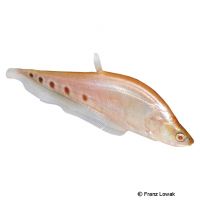Albino Indian Featherback (Chitala chitala 'Albino')
| Albino Indian Featherback Chitala chitala 'Albino' | |
|---|---|
| Name | Albino Indian Featherback |
| Name Lat. | Chitala chitala 'Albino' |
| Family | Featherbacks |
| Family lat. | Notopteridae |
| Order | Bony Tongues |
| Order lat. | Osteoglossiformes |
| Origin | India |
| Habitat | Rivers, lakes |
| Diet | Carnivore |
| pH | 6.0-8.0 |
| Behavior | Nocturnal, peaceful |
| Keeping | Individual, group |
| Care Level | Experts only |
| Reproduction | Substrate spawner |
| Breeding | Difficult |
| Life Span | 8-10 years |
| Protection | No |
| Metric Units | |
| Size | 80 cm |
| Temperature | 24-28 °C |
| Hardness | 5-19 °dH |
| Aquarium | ~ 3.000 l |
| US Units | |
| Size | 30" |
| Temperature | 75-82 °F |
| Hardness | 90-340 ppm |
| Aquarium | ~ 800 gal |
Distribution and habitat
The crepuscular to nocturnal thousand dollar fish originate from India, where they are widely distributed in the Indus, Ganges-Brahmaputra and Mahanadi river systems. They live in rivers, lakes and swampy waters, usually hidden between dead wood or stones during the day.
Maintenance
The aquarium should have dense, robust marginal planting and provide plenty of swimming space, as well as sturdy stone structures with caves and roots that serve as hiding places. A deep, dark substrate of fine sand or gravel and highly subdued light (floating plant cover) is ideal.
No ammonia, ammonium and nitrite should be detectable, the nitrate value should not exceed 100 mg/l. To ensure the water quality and oxygen content, a filter and heater adapted to the aquarium size is required, as well as lighting for the species-appropriate day-night rhythm of the animals.
Diet
In nature they feed mainly on fish and invertebrates. The food supply consists of artemia, mysis, mosquito larvae, worms and fish (live or frozen) according to their size, supplemented with mussel and crab meat. Dry food (pellets, granules) is occasionally accepted, but should not be the main component of their diet
Feeding should be done towards evening. Only as much should be fed as will be eaten within a few minutes. A regular and varied diet promotes health and increases resistance.
Behaviour and compatibility
In too small tanks they behave very aggressive within the species. Accordingly, keeping a group is only recommended in a very large and richly structured tank. They are compatible with other fish, but should only be socialized with large and calm fish. Too small fish serve them as food.
Basically, only compatible fish species with similar demands on water condition and water temperature should be socialized.
Sex dimorphism
There are no known external distinguishing characteristics.
Reproduction and breeding
Little is known about reproduction. The eggs are attached to a solid substrate and hatch after about a week. The clutch is cared for and guarded by the male.
Important
The anal fin is fused with the caudal fin to form a fin seam. They swim by means of undulating movement of the fin seam equally well and equally fast forward as backward.
In oxygen-poor waters, they can also breathe atmospheric air with the help of their swim bladder
The well-being of the fish should be checked regularly. Temperature should be checked daily, pH, hardness and nitrate levels at least fortnightly. Regular partial water changes are recommended, even if the pollutant level has not yet reached the upper limit. Sudden changes in water quality should be avoided. Newly introduced fish must be accustomed slowly to the water in the aquarium.
Further literature can be found in your pet store.
References
Text: Werner Winter; Image: Franz Lowak
Source: BMELV (1998): Tierschutzgutachten - Haltung von Zierfischen (Süßwasser); BAENSCH & RIEHL (2004): Aquarien Atlas Bd. 2, Mergus Verlag; ENGELMANN (2005): Zootierhaltung - Tiere in menschlicher Obhut: Fische, Verlag Harri Deutsch
- Gemäß § 21 Abs. 5 Tierschutzgesetz idgF
